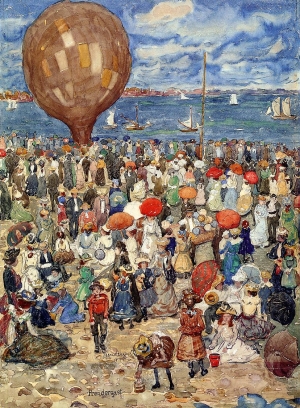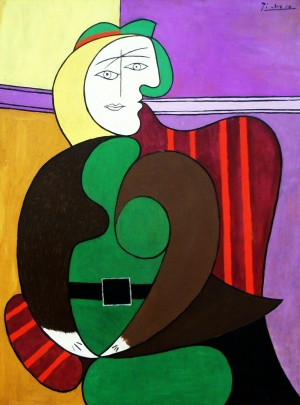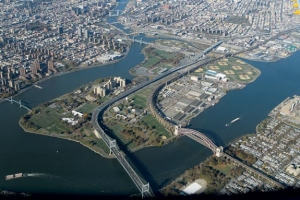|
Displaying items by tag: Armory Show
For the past hundred years the International Exhibition of Modern Art has been considered a signal event in the history of American art. Now known as the Armory Show, it was mounted by the Association of American Painters and Sculptors (A.A.P.S) in New York at the 69th Regiment Armory on Lexington Avenue, between East Twenty-fifth and Twenty-sixth Streets, from February 17 through March 15, 1913, and introduced avant-garde European art to an American audience. Some 1,400 works—paintings, drawings, prints, sculpture, and decorative objects by European and American artists—drew approximately 87,000 visitors, and sparked an impassioned debate over the nature and future of modern art that played out in the press, as well as in meeting rooms, drawing rooms, and dining rooms across the country. Portions of the exhibition later traveled to the Art Institute of Chicago and the Copley Society in Boston.

Maurice Prendergast: By the Sea, which is now on view at the Bowdoin College Museum of Art in Brunswick, Maine, explores the artist’s lifelong fascination with the sea. Maurice Prendergast, a pioneering post-Impressionist painter, spent much of the late 19th century and early 20th century capturing modern life on the coast of New England.
By the Sea is the first retrospective of Prendergast’s oeuvre in over two decades. The exhibition presents more than 90 works in a variety of media from over 30 public and private collections in addition to Bowdoin College Museum of Art’s own holdings. The exhibition traces the development of Prendergast’s highly personal style, which is recognized for its use of jewel-like colors and pattern-like compositions containing flattened, free-form figures. The exhibition also includes Prendergast’s sketchbooks and oil studies, allowing visitors to see into the Modernist artist’s creative process.
Highlights include the watercolor The Balloon, which is part of a private collection and has not been included in earlier Prendergast retrospectives; St. Malo, a bright watercolor on loan from the Williams College Museum of Art, which was lauded as one of the first American introductions of the bold European Post-Impressionist avant-garde; and a number of works that the artist contributed to the seminal Armory Show of 1913 (also known as the International Exhibition of Modern Art).
Maurice Prendergast: By the Sea will be on view at the Bowdoin College Museum of Art through October 13, 2013.
100 years after the 1913 Armory Show changed the landscape of American art forever, the current incarnation of the event opened to the public today, March 7, 2013. Mayor Michael Bloomberg held a press conference to inaugurate the 2013 Armory Show, which features 214 exhibitors from across the globe. The event is expected to draw about 66,000 visitors and will generate approximately $54 million in the city during its four-day run.
This year’s Armory Show features a specially curated section titled ‘Armory Focus: USA’ and aims to celebrate the remarkable impact the 1913 Armory Show had on the country. The section is curated by Eric Shiner, the director of The Andy Warhol Museum in Pittsburgh, PA and features 17 established and emerging galleries that focus on contemporary art.
The Armory Show is held on Piers 92 and 94 in central Manhattan and is part of the highly anticipated Armory Arts Week, a suite of cultural events and exhibitions taking place across the city from March 7-10, 2013.

In 1913, the Art Institute of Chicago became the first American art museum to present the work of the young Spanish artist, Pablo Picasso (1881-1973). One hundred years later, the museum is celebrating its important relationship with the artist with the exhibition Picasso and Chicago.
Picasso and Chicago features 250 works by the artist who went on to become one of the defining figures in 20th century art. Paintings, sculptures, prints, drawings, and ceramics from the museum’s holdings as well as private collections in the city will be on view. This is the first comprehensive Picasso exhibition organized by the Art Institute in nearly 30 years.
The Art Institute of Chicago began collecting works by Picasso after the seminal 1913 Armory Show, which revolutionized American modern art. Works on view from the museum’s collection include The Old Guitarist (1903-04), Mother and Child (1921), Red Armchair (1931), and the sculpture Cubist Head of a Woman (Fernande) (1909). The exhibit also features impressions of The Frugal Meal (1904), one of only three examples in the world of the well-known Blue Period etching actually printed in blue ink.
Picasso and Chicago will be on view through May 12, 2013.

100 years after the seminal Armory Show in New York City, The Heckscher Museum of Art presents Modernizing America: Artists of the Armory Show. On view through April 14, 2013, the exhibition features works from the museum’s permanent collection and explores the show that changed the country’s perception of modern art.
Organized by the Association of American Painters and Sculptors, the Armory Show, officially titled the International Exhibition of Modern Art, took place at the 69th Regiment Armory and introduced radical works of art to the public; a far cry from the realistic art they were accustomed to. Artists, critics, and patrons were presented with European works that boasted avant-garde sensibilities and spanned genres like Futurism, Cubism, and Fauvism. The show transformed the landscape of modern art and inspired an unmatched growth and progression in American art.
Works on view include paintings by Marguerite Zorach (1877-1968) and Arthur B. Carles (1882-1952); works on paper by Joseph Stella (1877-1946), Oscar Bluemner (1867-1938), and Charles Sheeler (1883-1965); and sculptures by artists such as Walter Kuhn (1877-1949).
The Heckscher Museum of Art was founded in 1920 by August Heckscher in Huntington, New York. The museum boasts over 2,000 works and focuses mainly on American landscape paintings as well as American and European modernism and photography.

March or May or both?
That is the key question facing galleries that want to participate in art fairs in New York next year, as a breathtaking—some might say absurd—number of art fairs vie for the attention of collectors and art dealers.
Frieze New York Comes Out Swinging
After 10 years in London, the Frieze Art Fair announced earlier this year that it was planning to start a New York edition in May 2012 on Randall’s Island—the square-mile piece of land across the East River from Spanish Harlem, which was once the headquarters of Robert Moses.
Shortly before Thanksgiving, Frieze released a formidable exhibitor list, with about 170 names, including more than 30 top-flight galleries from New York, like 303, Gavin Brown’s Enterprise, David Zwirner, Friedrich Petzel, Metro Pictures and Green Naftali. High Line curator Cecilia Alemani has been hired to organize its projects and public programs.
Since some dealers had been grumbling about the fair’s ostensibly far-flung location, director Amanda Sharp and company must have been very persuasive. For one thing, they have emphasized that the island, which will be home to a “bespoke” tent designed by Brooklyn architecture firm SO-IL, is a mere 15-minute car ride from downtown Manhattan.
Armory Show Readies List, Hires Winkleman
The Armory Show—New York’s biggest contemporary art fair—is set to arrive in March, on Hudson River Piers 92 and 94. It has not yet released its list of galleries (it typically waits until January, though Lisson, Sean Kelly, Massimo de Carlo, Boesky and Victoria Miro are rumored to be on board), but it has already said it will trim last year’s total of 274 participants by about 50.
Many galleries that participated in last year’s Armory Show—among them Andrew Kreps, Marianne Boesky and Lehmann Maupin—have signed on for Frieze’s inaugural edition. How many dealers will be willing to do two New York fairs in as many months? That may depend on the prices they are offered for booths.
Meanwhile, the Armory has tapped Chelsea gallerist Edward Winkleman to curate a new section called Armory Films, which will bring a variety of filmic art to a media lounge at the fair. Mr. Winkleman has been a visible video booster for years, and last year launched a video-only art fair called Moving Image during the week of the Armory.
Is Mr. Winkleman worried about being co-opted by the larger fair? “Believe it or not,” he told us on the phone from Miami, “I think Armory and Moving Image are complementary. Last year, about half our galleries did another fair. Moving Image is an opportunity to show your video work at the same time as another fair. You do not have to darken your whole booth. You as the gallery can focus on doing the other fair.”

As the Armory Show art fair prepares for next year’s edition, in March, and faces down new competition from London’s Frieze Art Fair, which will launch a New York edition on Randall’s Island in May, its organizers are making major changes.
Katelijne De Backer, who joined the Armory in 2000, has stepped down, fair planners announced today. They also revealed that next year’s fair, which alights on Piers 92 and 94 in March, 2012, will feature fewer galleries than last year, and sport a new design conceived by architectural firm Bade Stageberg Cox.
The plans were announced today by Paul Morris, at a press event at the Gramercy Park Hotel, where Mr. Morris, along with fellow dealers Pat Hearn, Colin de Land and Matthew Marks launched the fair — as the Gramercy International Art Fair — back in 1994. (A taste of the fair’s second edition, in 1995, is available in the archive of GalleryBeat.) Mr. Morris is replacing Ms. De Backer as head of the Armory, as founding director.
The number of galleries in the 2012 Armory Show will be trimmed by about 40 in the Pier 94 contemporary section and by around 10 in the Pier 92 modern section. In total, the 2011 edition of the fair featured 274 galleries. “Our dealers want us to have a more focused group, with larger spaces,” Mr. Morris said. Price points for booths will remains the same, meaning that the Armory will make less money from exhibitors than in past years.
The reduced number of exhibitors, Mr. Morris said, will also allow Bade Stageberg Cox to create open spaces within the halls, which will allow people to congregate and orient themselves in the typically packed, confusing corridors. And there is good news for those who bemoaned the death-defying climb from 94 to 92: that forbidding metal staircase has been nixed. Instead, a passageway of some type will connect the two buildings.

There are over 600 galleries spread over seven art fairs vying for collectors and sales during New York’s unofficial arts week. And that’s not counting the smaller satellites and numerous gallery shows from Chelsea to Brooklyn. Elsewhere there is a dominant beast: in Miami it is Art Basel and London has Frieze, but there is no über art fair in New York. Does Manhattan really need one? Or does competition bring out the best in everyone?
The Armory Show, founded by four entrepreneurial art dealers in 1994 and first held at the Gramercy Hotel, has grown into a corporate-run event filling two piers. But several major dealers have jumped ship in recent years. And there is a power play between the city’s rival fairs.
The Art Show, run by the Art Dealers Association of America (ADAA), moved its dates last year, going toe-to-toe with the Armory Show, which had encroached on the ADAA’s traditionally blue-chip turf in 2009 by introducing the Armory Show-Modern. Things heated up further when the young pretender, Independent, entered the fray last year, taking over the former Dia building in Chelsea to create refreshingly alternative, booth-free displays of international contemporary art.
This year all three fairs return. Some say the shifting of the art world’s tectonic plates is beneficial. “There’s a healthy competition that’s breeding excellence,” says Mari Spirito, the director of 303 Gallery (P94/1300), whose sales include Eva Rothschild’s, Jokes, 2007, for €45,000, to a New York-based collector. Maureen Paley, showing at Independent, agrees: “Diversity is never a bad thing, and the city has a broad enough base to support it. New York maintains its position as a diverse magnet.” Paley’s early sales include David Salle’s I’ve Got It All Up Here, 2010. The artist’s large-scale works sell for around $300,000.
|
|
|
|
|